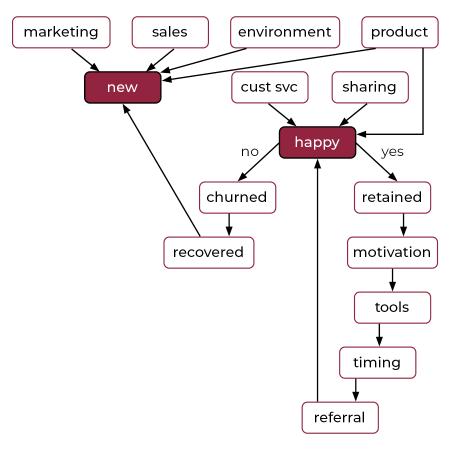We live in interesting times. The average American parent is a symphony of distraction, their attention divided among work emails, club sports, school events, and an endless stream of news and social media updates.
They’re like jugglers, constantly trying to keep all the balls in the air, and sometimes one of those balls falls to the ground. The constant barrage of distractions makes it hard to focus, to be present, and to truly connect with their families. So they’re getting pickier about where they spend their time. This reality has consequences for those of us in the marketing world.
Advertising adds to the distraction and is everywhere our customers look. Companies spend billions of dollars to hack five seconds of attention from our personal whirlwinds of activity. Many of those advertising billions are controlled by evolving algorithms in constant search of 0.1 percent improvement in return on investment (ROI). A booming online business can be wiped out by a search engine update in a New York minute.
Marketing channel operators do not share your camp’s goals. Search engines, magazines, cable TV, and all the rest have one goal: to maximize revenue and profit. Google, for instance, wants you to spend as much money as possible for the smallest result you find worthwhile, and their auction algorithms work tirelessly toward that goal. They aren’t in business to make your marketing cheap.
But we’re not here to pick on Google, media, or anybody else. The marketing channel operators, like the rest of us, are doing the best they can. Neither are we complaining about the current state of the world. (I’m a firm believer that the world is OK. Call me an optimist.)
The point is that these channels make shaky foundations upon which to build your business in this rapidly evolving world. Algorithms change and consultants retire, change jobs, or are absorbed by other concerns. Most of it is outside of your control and will at times leave you feeling like a ping-pong ball. The constant change can truly be exhausting. So wouldn’t it be great if your marketing and sales processes were under your control?
You Need a Referral Machine
Referral marketing is a beacon of efficiency and reliability, and it is largely within your control. For summer camps looking to boost their enrollment and foster long-term relationships with families, understanding and fully harnessing the potential of referral marketing can be a game-changer. You’ll spend less time and money on marketing and more time and money building relationships with your families and improving your camp.
Understanding the Big Picture
Figure 1 shows that new customers (other than recycled churn) flow in from the outside from a magical witch’s brew of marketing, sales, business environment, and product qualities. Once a new customer makes a purchase, they reside in your “happiness process.” The customer’s happiness is determined by a mixture of customer service, shared identification, and product characteristics. If they stay happy, they return next year and are retained. This is where you feed them what they need to become your ambassadors who refer new customers.
While you may have a recovery program to attempt to win back a percentage of unhappy clients, for the most part, if they aren’t happy, they churn.
This is a simplified look at the process, but it’s an appropriate framework on which to base further discussion.

Figure 1: The Referral Process
“I Already Have a Referral Program”
We hear that a lot, but it’s the wrong answer. Organic referrals are always happening. You should be asking, “Can it be better?”
- Do you give the best tools to every possible ambassador?
- Do you have multiple information packets for them to share with friends?
- Do you throw parties for them to invite their friends?
- Do you have a referral marketing calendar?
- Can you name your best ambassadors?
- Did you miss anyone?
- Do you tell new customers that you have an active and successful referral program?
On a sidenote, some people question whether referrals can be managed at all. The argument is that referrals are like thunderstorms: they happen when they happen. And for many referral programs, that’s how it works. You certainly can’t dial up referrals the way you turn up your radio’s volume. But you can control your referrals. There are too many successful businesses in similar markets that rely exclusively on referrals. Heck, there’s an entire industry of marketing professionals, and more than one book about orthodontists using referral marketing to build their practices. As it turns out, orthodontist referral success stories are a dime a dozen. If they can do it, you can too!
But you’ll need to build your referral machine piece by piece. In the same way that a house can’t be built without site preparation, a foundation, and sewer hookups, referral machines have prerequisites.
The Foundations of a Referral Machine
Referral machines rest on a base of happy, repeat customers. Pick up any of the 50+ referral marketing books out there and the first 75 percent will be about retention. The logic is simple: You can’t get referrals from customers you don’t have.
Why do customers stick around? I like the following description:
Shared interest + shared space + shared concern = customer retention
Shared interests are areas of your life that overlap with your customers. This should be easy for camps. Maybe you’re an animal camp. Your camp is filled with animal people, or people who want to be animal people. Guess what theme should be ever-present in your communications and branding?
Shared space is about being present in your customers’ lives. Shared space is why you give away cool clothes, bags, calendars, coffee mugs, and other swag with your camp logo on them. It’s why you mail physical newsletters, birthday cards, and birthday presents. You’re trying to create a routine presence in your customers’ lives. Many referrals happen casually. Two moms are chatting while their kids play on a playground. One of the moms sees the cool “Camp Wonderful” sweatshirt and asks about it. Bingo!
Shared concern is the hardest of the three. One-sided relationships don’t work. Your customers need to feel like they know you and what you care about. You need to let them see that you care about their children, their lives, and at least a few of their causes. If you share who you are with your customers, and they agree with you, you will build a lasting relationship.
Here’s a minor detour on our journey. We must know what level of customer retention is possible. Personally, I’ve never succeeded at anything impossible, so let’s focus on what’s possible. I can’t give you an exact number for your camp, but I can say that most professional service businesses (orthodontists, dentists, lawyers, etc.) lose 12 percent per year, no matter how well they are run. People lose jobs, move, or die.
Summer camps will probably lose more because children age out. So, if your camp has six years of possible attendance, you will lose one-sixth of your kids every year. Do a little math with the number of kids per family, and you’ll have the theoretical limit to your retention, which you will never attain because of the natural loss rates previously mentioned.
A Quick Note about Unique Product Attributes
Most businesses think their product is unique and that is what attracts customers. But all too often their customers don’t agree, and this assertion does not withstand scrutiny. As it turns out, product differentiation is hard.
Is there an easier way to stand out? Focus on customer service. Impeccable customer service keeps customers coming back. Mediocre customer service destroys trust and feeds churn.
Understanding the Referral
Giving a referral represents a significant personal risk. Your goal is to do everything possible to reduce, or better yet eliminate, that risk.
Your customers will not take that risk if they don’t think you will handle the referral quickly, professionally, and courteously. Their judgment on this subject will be based on their past interactions with your business, which takes us back to customer service. It needs to be excellent.
Here are a few tips to help you build customer trust and encourage referrals without having to ask directly:
Give your customers interesting stories to talk about. Don’t be all ask and no give. Establish a pattern of communicating with your families without asking for anything. Give them fun stories about their own children if you can. They will share.
Make monetary incentives meaningful. Monetary incentives may work well for your demographic, but you must make the incentives meaningful. Lowball monetary incentives send the wrong message. Keep in mind that in referral marketing, you only pay for actual results.
Make all incentives appropriate. This is tricky, depending on your demographic. At higher income levels, customers are more likely to act on feelings of charity than on monetary incentives. Instead of money, consider offering contributions to a scholarship fund or something similar.
Make it easy. Give your families tools to make sending and tracking the referral as painless as possible. Self-addressed, stamped cards, QR codes, or software programs can help here. A ton of work is required to manage active referral programs. Use tools to help.
Don’t start with an ask. Give your camp families something to give to their friends. Then they aren’t asking their friends to buy something right off the bat. Instead, they’re offering a gift. This tactic works for many businesses. Think it through, and make it work for your camp. Books, pictures, food for the parents, or toys for the kids are good places to start.
Set expectations. Tell new customers about your referral programs, and let them know, tactfully, how grateful you are that so many of your current customers give referrals. Thank referrers publicly if you can. Appeal to your camp community’s sense of shared cause.
Use referrals to recruit staff. If you use referrals to recruit staff, monetary incentives can be the key that opens the floodgates. Again, don’t be penny wise and pound foolish. It turns people off. “You want me to do what for a cup of coffee?” Do the math and determine what new customers or staff really cost. Then offer a commensurate reward.
Use your shared cause tactfully. Most camps believe they are doing good things for kids — and they are. Your customers should understand that they are advancing your shared cause when they make a referral. At the most basic level, referrals are an extremely cost-effective way to gain customers. Every dollar not spent on marketing is a dollar to spend on your cause. Above all, always be honest and truthful about what’s happening.
Key Takeaways
- You must be referral worthy.
- Customers who refer are better customers. They are more loyal.
- Referred families are better customers. They churn less.
- Referrals cost the least to acquire. By far.
- Spending less for better customers lets you focus on your camp.
Don’t underestimate your ability to manage and amplify the referral process. It can be done, and it has been done. Many times. But it won’t happen overnight, and you may need some help. Don’t be afraid to reach out to organizations you know that employ a referral program or seek professional assistance from a company whose business is to build referral machines.
Photo courtesy of Cranbrook Schools Summer Camps, Bloomfield Hills, MI.
Patrick Brannan is the president of Camp Tree, a software system that automates the tedious parts of referral marketing. Prior to Camp Tree he built and sold a successful SaaS company. He actively participated in the St. Louis startup community as an owner and consultant for more than 20 years.



